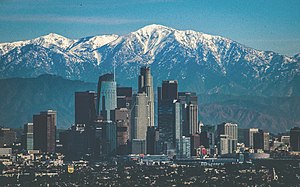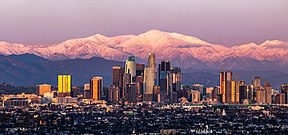
Back منطقة لوس أنجلوس الكبرى Arabic Gran Los Angeles AST Böyük Los Anceles AZ قرئیتر لوس آنجلس AZB Район на Голям Лос Анджелис Bulgarian Greater Los Angeles Area Catalan Greater Los Angeles Area German Granda Los-Anĝeleso EO Gran Los Ángeles Spanish Los Angeles Handia EU
Los Angeles Metropolitan Area | |
|---|---|
| Los Angeles–Long Beach–Anaheim, CA MSA | |
 | |
| Coordinates: 34°03′N 118°15′W / 34.05°N 118.25°W | |
| Country | United States |
| State(s) | California |
| Largest city | Los Angeles |
| Area | |
| • Total | 4,850.3 sq mi (12,562 km2) |
| Highest elevation | Mount San Antonio 10,064 ft (3,069 m) |
| Lowest elevation | Wilmington −9 ft (−3 m) |
| Population (2023)[2] | |
| • Total | 12,872,322 |
| • Rank | 2nd in the U.S. |
| • Density | 2,654/sq mi (1,025/km2) |
| GDP | |
| • MSA | $1.227 trillion (2022) |
| Time zone | UTC–8 (Pacific) |
| • Summer (DST) | UTC–7 (PDT) |


Greater Los Angeles is the most populous metropolitan area in the U.S. state of California, encompassing five counties in Southern California extending from Ventura County in the west to San Bernardino County and Riverside County in the east, with Los Angeles County in the center, and Orange County to the southeast. The Los Angeles–Anaheim–Riverside combined statistical area (CSA) covers 33,954 square miles (87,940 km2), making it the largest metropolitan region in the United States by land area. The contiguous urban area is 2,281 square miles (5,910 km2),[1] whereas the remainder mostly consists of mountain and desert areas. With a population of 20.6 million in 2023,[2] it is the second-largest metropolitan area in the country, behind New York, as well as one of the largest megacities in the world.[6]
In addition to being the nexus of the global entertainment industry, including films, television, and recorded music, Greater Los Angeles is also an important center of international trade, education, media, business, tourism, technology, and sports.[7] It is the third-largest metropolitan area by nominal GDP in the world with an economy exceeding $1 trillion in output, behind New York City and Tokyo.
There are three contiguous component urban areas in Greater Los Angeles: the Inland Empire, which can be broadly defined as Riverside and San Bernardino counties; the Ventura/Oxnard metropolitan area (Ventura County); and the Los Angeles metropolitan area (also known as Metropolitan Los Angeles or Metro LA) consisting of Los Angeles and Orange counties only. The Census Bureau designates the latter as the Los Angeles–Long Beach–Anaheim metropolitan statistical area (MSA), the fourth largest metropolitan area in the western hemisphere and the second-largest metropolitan area in the United States, by population of 13 million as of the 2020 U.S. census. It has a total area of 4,850 square miles (12,561 km2). Although San Diego–Tijuana borders the Greater Los Angeles area at San Clemente and Temecula, it is not part of it as the two urban areas are not geographically contiguous due to the presence of Camp Pendleton. However, both form part of the Southern California Megalopolis which extends into Tijuana, Baja California, Mexico. Throughout the 20th century, Greater Los Angeles was one of the fastest-growing regions in the United States, but growth has slowed since 2000.
- ^ a b "Census Urban Area List". United States Census Bureau. Archived from the original on November 15, 2018. Retrieved September 30, 2016.
- ^ a b c "Metropolitan and Micropolitan Statistical Areas Population Totals and Components of Change: 2020–2022". U.S. Census Bureau. Archived from the original on October 31, 2023. Retrieved November 30, 2023.
- ^ a b Cite error: The named reference
Los Angeles-Long Beach-Anaheim, CA (MSA)was invoked but never defined (see the help page). - ^ Cite error: The named reference
Riverside-San Bernardino-Ontario, CA (MSA)was invoked but never defined (see the help page). - ^ Cite error: The named reference
Oxnard-Thousand Oaks-Ventura, CA (MSA)was invoked but never defined (see the help page). - ^ [1] Archived July 4, 2010, at the Wayback Machine World's Largest Metropolitan Areas, 2012
- ^ "Revealed: Cities that rule the world". CNN. April 10, 2010. Archived from the original on November 24, 2011. Retrieved October 20, 2011.





